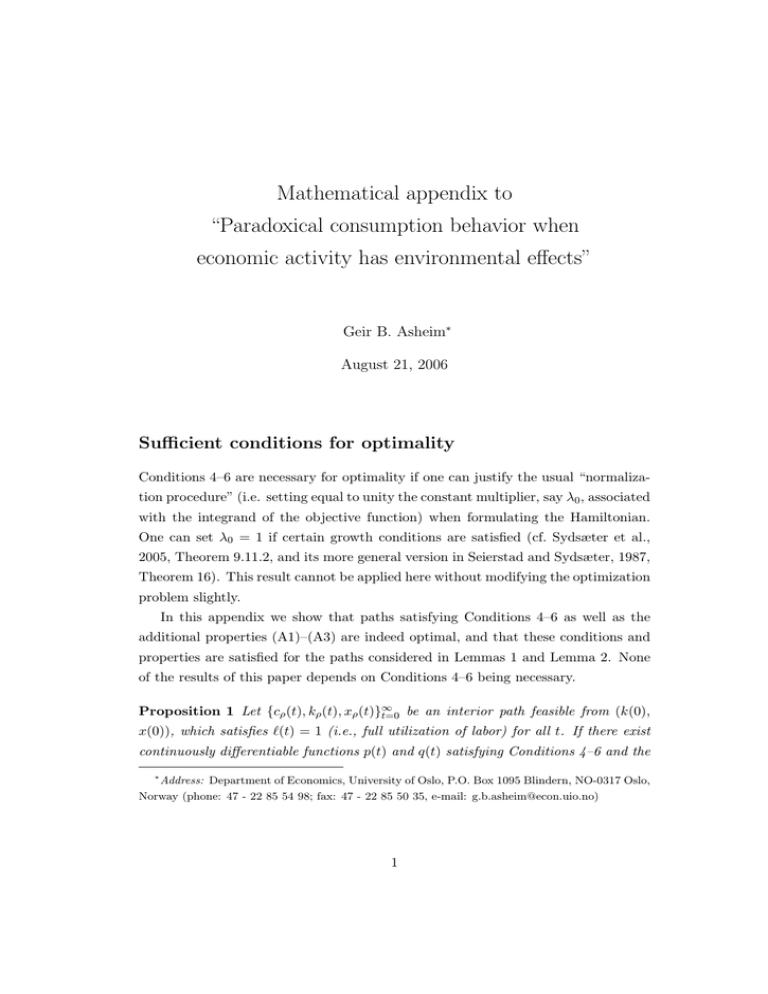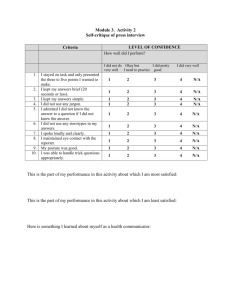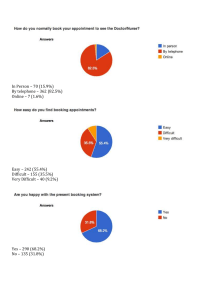Mathematical appendix to “Paradoxical consumption behavior when economic activity has environmental effects”
advertisement

Mathematical appendix to
“Paradoxical consumption behavior when
economic activity has environmental effects”
Geir B. Asheim∗
August 21, 2006
Sufficient conditions for optimality
Conditions 4–6 are necessary for optimality if one can justify the usual “normalization procedure” (i.e. setting equal to unity the constant multiplier, say λ0 , associated
with the integrand of the objective function) when formulating the Hamiltonian.
One can set λ0 = 1 if certain growth conditions are satisfied (cf. Sydsæter et al.,
2005, Theorem 9.11.2, and its more general version in Seierstad and Sydsæter, 1987,
Theorem 16). This result cannot be applied here without modifying the optimization
problem slightly.
In this appendix we show that paths satisfying Conditions 4–6 as well as the
additional properties (A1)–(A3) are indeed optimal, and that these conditions and
properties are satisfied for the paths considered in Lemmas 1 and Lemma 2. None
of the results of this paper depends on Conditions 4–6 being necessary.
Proposition 1 Let {cρ (t), kρ (t), xρ (t)}∞
t=0 be an interior path feasible from (k(0),
x(0)), which satisfies `(t) = 1 (i.e., full utilization of labor) for all t. If there exist
continuously differentiable functions p(t) and q(t) satisfying Conditions 4–6 and the
∗
Address: Department of Economics, University of Oslo, P.O. Box 1095 Blindern, NO-0317 Oslo,
Norway (phone: 47 - 22 85 54 98; fax: 47 - 22 85 50 35, e-mail: g.b.asheim@econ.uio.no)
1
following additional properties,
p(t) > 0
and
limt→∞ p(t)e−ρt = 0
q(t) > 0
for all t ,
limt→∞ q(t)e−ρt = 0
d (p(t) − q(t)) xρ (t)e−ρt
≤ 0 for all t ,
dt
and
(A1)
(A2)
(A3)
then {cρ (t), kρ (t), xρ (t)}∞
t=0 is the unique optimal path from (k(0), x(0)).
Proof. Showing sufficiency is complex because xf (k) is not a concave function.
Note that (A2) and (A3) imply (p − q)xρ ≥ 0 and p − q ≥ 0 for all t ≥ 0 since the
path is interior. Let {c(t), k(t), x(t)}∞
t=0 be any path feasible from (k(0), x(0)). This
alternative path may have partial utilization of labor; hence, we only require that
{`(t)}∞
t=0 is a piecewise continuous path satisfying 0 ≤ `(t) ≤ 1 for all t. Then
Z ∞
u(c) − u(cρ ) e−ρt dt
Z0 ∞ h
=
u(c) − u(cρ ) + p xf˜(k, `) − c − δk − k̇ − xρ f (kρ ) − cρ − δkρ − k̇ρ
0
i −ρt
˜
+ q g(x) − xf (k, `) − ẋ − g(xρ ) − xρ f (kρ ) − ẋρ
e dt
(by Conditions 1 and 2)
Z ∞h
≤
(p − q) x − xρ f˜(k, `) − f (kρ )
0
− p (k̇ + δk) − (k̇ρ + δkρ ) + (p − q)xρ f˜(k, `) − f (kρ )
i
− q (ẋ − g(x)) − (ẋρ − g(xρ )) + (p − q) x − xρ f (kρ ) e−ρt dt
(by Condition 6 and by rearranging terms). Conditions 4 and 5 imply that the four
last terms are non-positive since
(a) (p − q)xρ f˜(k, `) − f (kρ ) ≤ k − kρ (p − q)xρ f 0 (kρ )
by f 00 < 0 and (p − q)xρ ≥ 0 since f˜(k, l) ≤ f (k)
(b) q g(x) − g(xρ ) ≤ x − xρ qg 0 (xρ )
(c) −
R∞
(d) −
R∞
0
0
by g 00 < 0 and q > 0,
R∞
p k̇ − k̇ρ e−ρt dt = 0 k − kρ (ṗ − pρ)e−ρt dt,
R∞
q ẋ − ẋρ e−ρt dt = 0 x − xρ (q̇ − qρ)e−ρt dt,
2
where (c) and (d) follows from (A2) using integration by parts. Concerning the first
term, Assumption 1 and Condition 1 imply that
x − xρ
f˜(k, `) − f (kρ ) ≤ x − xρ
ẋρ ẋ
−
xρ x
,
because sgn x − xρ = sgn g(kρ )/xρ − g(x)/x = sgn (ẋρ + xρ f (kρ ))/xρ − (ẋ +
f˜(k, `))/x = sgn (ẋρ /xρ − ẋ/x) − (f˜(k, `) − f (kρ )) . Since p − q ≥ 0, it therefore
follows that
Z ∞
Z ∞
ẋρ ẋ −ρt
−ρt
(p − q) x − xρ
u(c) − u(cρ ) e dt ≤
−
e dt
xρ x
0
0
Z ∞
Z ∞
x
d
=
(p − q)xρ
− 1 dt
ln xρ − ln x e−ρt dt =
(p − q)xρ e−ρt e−m − 1 ṁdt ,
xρ
0
0
where m(t) is defined by m(t) := ln xρ − ln x. Note that m(0) = 0. Let T be an
arbitrary positive number. Then, using integration by parts,
Z T
(p − q)xρ e−ρt e−m − 1 ṁdt
0
= (p(0) − q(0)) xρ (0) − (p(T ) − q(T )) xρ (T )e−ρT e−m(T ) + m(t)
Z T
−m
−ρt
d
(p
−
q)x
e
e
+
m
dt
+
ρ
dt
0
Z T
−ρt
d
≤ (p(0) − q(0)) xρ (0) − (p(T ) − q(T )) xρ (T )e−ρT +
dt ,
dt (p − q)xρ e
0
since (p(T ) − q(T )) xρ (T ) ≥ 0, d (p − q)xρ e−ρt /dt ≤ 0 for all 0 < t < T by (A3),
and e−m +m ≥ 1 for all m. The last expression is equal to zero, and the optimality of
{cρ (t), kρ (t), xρ (t)}∞
t=0 follows by letting T approach infinity. Uniqueness is implied
by g 00 < 0 and q > 0.
The existence, uniqueness, and saddle point characteristics of (x∗ρ , z ∗ ).
Consider equations (7) and (8). Extend the domain of κ(·) to non-positive values
of z as follows: κ(z) = 0 for z ∈ (−∞, 0]. Then ξ(κ(·)) is a continuous function from
R into [0, x̄] with the following properties:
xρ = ξ(κ(z))
ξ(κ(z)) = x̄ for z ∈ (−∞, 0]
implies ẋρ = 0
and ξ(κ(z)) ∈ [0, x̄) for z ∈ (0, ∞) .
Since ∂ ż/∂z = g(xρ )/xρ − g 0 (xρ ) + ρ ≥ ρ > 0 for all z and xρ and ż = g(xρ ) if
z = xρ , there exists a continuous function from ζ(·) from [0, x̄] into R with the
3
z
(ξ(κ(z)), z)
HH
H
(xρ , ζ(xρ ))
ż > 0
ẋρ < 0
H
stable
H
manifold
ż > 0 HH
s H
ẋρ > 0
H
HH (xρ (τ ), z(τ ))
H
ż < 0
HH
ẋ
H
ρ <0
ż < 0 HH
H
ẋρ > 0
HH
xρ
∗
x̄
xρ
z∗
Figure 1: A phase diagram.
following properties
z = ζ(xρ )
ζ(0) = 0 ,
if and only if ż = 0
ζ(xρ ) < xρ for xρ ∈ (0, x̄) ,
and ζ(x̄) = x̄ .
By Brouwer’s fixed point theorem, there exists x∗ρ ∈ [0, x̄] such that x∗ρ = ξ(κ(ζ(x∗ρ ))).
It follows that 0 < x∗ρ < x̄ and z ∗ = ζ(x∗ρ ) > 0 since
x∗ρ = 0
⇒
⇒
z ∗ = ζ(x∗ρ ) ≤ 0
z ∗ = ζ(x∗ρ ) > 0
⇒
⇒
x∗ρ = ξ(κ(z ∗ )) = x̄
x∗ρ = ξ(κ(z)) < x̄ .
Furthermore, z ∗ < x∗ρ , since z ∗ = ζ(x∗ρ ) ≥ x∗ρ implies x∗ρ = 0 or x∗ρ = x̄. Finally,
(x∗ρ , z ∗ ) is unique and has saddle point characteristics since
∂ ẋρ
∂ ẋρ
< 0 and
< 0 when xρ = ξ(κ(z)) ∈ (0, x̄)
∂xρ
∂z
∂ ż
∂ ż
< 0 and
> 0 when z = ζ(xρ ) ∈ (0, xρ ) .
∂xρ
∂z
These results are illustrated by a phase diagram in Figure 1.
4
Lemma 1 and sufficient optimality conditions.
Properties (A1) and (A2) are satisfied since both p and q are positive and constant.
Property (A3) is satisfied since (p − q)xρ ≡ p∗ (1 − v ∗ )x∗ρ ≡ p∗ z ∗ is positive and
constant.
Lemma 2 and sufficient optimality conditions.
If p > 0, then it follows from Conditions 1, 4, and 5 that
ż =
z
xρ g(xρ )
− (xρ − z) zf 0 (kρ ) − δ − g 0 (xρ ) ,
(A4)
which becomes (8) under the additional assumption that ṗ = 0. Since {kρ }∞
t=0 and
{xρ }∞
t=0 are absolutely continuous, it follows that z is continuously differentiable.
The convergence phase. By the linearity of u, Condition 6 is satisfied by letting
p = p∗ > 0 for all t ≥ τ . Since p > 0 and ṗ = 0 for t ≥ τ , {xρ (t), z(t)}∞
t=τ moves along
the stable manifold of Figure 1 leading to the saddle point (x∗ρ , z ∗ ). The properties
of the converging path from (xρ (τ ), z(τ )) with xρ (τ ) > x∗ρ imply that z > 0 and
ż < 0 for all t ≥ τ . It follows from (6), (7), and (8) that Conditions 4 and 5 are
satisfied by letting q = p∗ v ≡ p∗ 1 − z/xρ for all t ≥ τ .
The investment phase. Turn now to the properties of p and q for 0 < t < τ when
Conditions 4 and 5 are imposed. Since p(τ ) = p∗ > 0 and p is continuous, we must
have p > 0 for all t > τ − , for some > 0. Hence, (A4) holds for τ − < t < τ .
Furthermore, for τ − < t < τ ,
(a) z = xρ implies ż > 0 by (A4) since 0 < xρ < 1,
(b) z ∈ (0, xρ ) and ż = 0 imply that dż/dt exists and is positive since (A4) holds,
and k̇ρ > 0 and ẋρ ≤ 0 (by the proof of Lemma 2).
Hence, z(τ ) > 0 and ż(τ ) < 0 imply that z < x for τ − < t < τ by (a) and z > 0
and ż < 0 for τ − < t < τ by (b). Therefore, 0 < z < xρ and ż < 0 for τ − < t < τ .
It follows from the previous paragraph that kρ < kρ (τ ) = κ(z(τ )) < κ(z) for
τ − < t < τ , since k̇ρ > 0 and ż < 0 for τ − < t < τ and κ is strictly increasing.
By (5) (which follows from Condition 5) and (6) this means that
− pṗ = zf 0 (k) − (ρ + δ) > zf 0 (κ(z)) − (ρ + δ) ≡ 0
for τ − < t < τ since z > 0, implying that ṗ < 0 for τ − < t < τ . This implies
that we can set = τ , so that p > p∗ and ṗ < 0 for 0 < t < τ . Therefore, 0 < z < xρ
and ż < 0 for 0 < t < τ .
5
It follows from the above analysis that, for 0 < t < τ , Conditions 4 and 5 are
satisfied by construction, while Condition 6 is satisfied since p > p∗ and cρ = 0.
The analysis of the convergence and investment phases entails that p > 0, ṗ ≤ 0,
0 < z < xρ , and ż < 0 for all t > 0. Since thus p > 0 and q = pv = p(1 − z/xρ ) > 0
for all t > 0, property (A1) is satisfied. Furthermore, both p and q converge to
the positive constants p∗ and q ∗ := p∗ 1 − z ∗ /x∗ρ , implying that property (A2) is
satisfied. Finally, (p − q)xρ ≡ pz is positive and decreasing, implying that property
(A3) is satisfied.
References
Seierstad, A., Sydsæter, K., 1987. Optimal Control Theory with Economic Applications.
Amsterdam: North-Holland.
Sydsæter, K., Hammond, P.J., Seierstad, A., Strøm, A., 2005. Further Mathematics for
Economic Analysis. Harlow: Prentice Hall.
6




